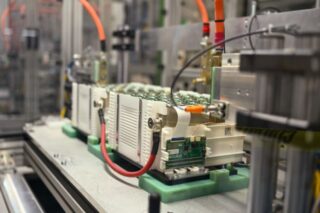Dave Duncan is the Vice President of Sustainability at PTC, a software provider based in Boston. He recently completed a tour of Europe, where he met with various manufacturers. He shared his insights into the maturity of European manufacturers concerning sustainability.
PTC has spent years integrating features to help businesses design products with sustainability in mind. Based on your recent tour across Europe, how do you evaluate the maturity of the companies you visited in terms of their sustainability practices?
Dave Duncan: “We engaged with about 200 manufacturers during our tour. Approximately 20% of these companies have been actively pursuing sustainability for some time, while the remaining 80% are just beginning to address it, often on a tactical level in specific departments like engineering, manufacturing, and service. The push for sustainability is partly driven by new regulations, prompting these businesses to seek initial guidance on how to start their journey.
Automotive and automotive supply chain companies seem to be among the more mature in this regard, likely due to their earlier transition to electrification. Additionally, companies focused on green products, like those in wind turbine production, tend to incorporate green metrics into their value propositions and thus started earlier on the sustainability path.
Overall, there’s strong commercial motivation to embrace sustainability among the companies we spoke to, with the majority expressing enthusiasm for making meaningful changes. This has contributed to a generally positive outlook on the future of sustainable practices within these industries.”
How do you compare the European and U.S. markets?
Dave Duncan: “I’ve been in Europe since mid-February, and before that, I spent considerable time with American manufacturers and sustainability leaders. While the EU’s Corporate Sustainability Reporting Directive (CSRD) is the number one priority for European companies, it’s also a major focus for manufacturers in the U.S., as well as in China and Japan. The reason is simple: any company with over €150 million in business in the EU must comply with these regulations.
U.S. manufacturers have a 12-month grace period compared to their European counterparts. This allows them to be “fast followers” by observing how European companies implement the new regulations before making their own adjustments. However, some international manufacturers are moving quickly because they see sustainability as a competitive advantage or face pressure from customers and investors to act.
While most American manufacturers acknowledge the importance of these new regulations, they believe they can move more quickly and efficiently after watching the initial implementation by European companies. This advantage allows them to learn from the early adopters in Europe, which ultimately leads to a smoother transition for the U.S. and other international manufacturers when they start implementing similar sustainability measures.”
How do you respond to a manufacturer seeking guidance on how to begin their sustainability journey?
Dave Duncan: “When a manufacturer approaches us for advice on starting their sustainability journey, we provide them with a comprehensive framework for greenhouse gas accounting. This framework helps them identify their baseline emissions, pinpoint hot spots, and understand the targets required for a science-based approach to sustainability. Our focus is initially on 2030 goals, which aim to reduce Scope 1 and Scope 2 emissions by 50% and the largest Scope 3 categories by 25%.
The primary source of emissions for many manufacturers lies in Scope 3, particularly in purchased goods and services. This has implications for material supply, scrap rates in factories, supplier components, and circular practices. We also find that refurbished and remanufactured equipment can be up to 90% more carbon-efficient. To address these challenges, we recommend that manufacturers start with mature digital solutions.”
Can you be more specific?
Dave Duncan: “The first key area is CAD optimization. Here, engineers can leverage generative design, simulation, and material selection tools to choose more sustainable materials, use fewer materials, and select more efficient manufacturing processes. This can significantly reduce waste and resource use at the part level.
Next, we suggest preparing for automated environmental product declarations (EPDs). With over 300 million SKUs (stock-keeping units) in the European Union and billions globally, there’s a significant gap in material life cycle analyses, with only about 250,000 completed so far. Automation will be crucial in meeting the regulatory requirements for EPDs, and much of this automation depends on improving the information in bills of material (BOMs). Manufacturers need to consider factors like material information, supplier details, modularity options, weight, and various sustainability attributes such as carbon density, water density, recycled content, and recyclability.
Another critical step is focusing on digital product passports, which extend EPDs by incorporating real-world tracking of equipment, spare parts, and products. Although these standards are still evolving, battery manufacturers will need to comply with digital product passport requirements by 2027, providing a clear timeline for adoption.
By advising manufacturers on improving their BOMs and integrating these sustainability dimensions into their existing product life cycle management processes, we aim to support them in their transition towards a more sustainable future without drastic overhauls. The mechanisms are already in place; it’s about refining the data sources and focusing on new simulations.”
How do you distinguish yourselves from your competitors?
Dave Duncan: “To truly achieve sustainability, you need comprehensive life cycle design and execution. What sets us apart is our unique integration of Product Lifecycle Management (PLM) and Service Lifecycle Management (SLM). This allows us to extend our solutions beyond the initial product design and into the maintenance and service phases.
For example, a refurbished laptop, according to one of our suppliers, is 92% more carbon-efficient than a new one. Similarly, a mining company in Lyon indicated that their refurbished drills are 80% more carbon-efficient than new ones, with the added benefit of new warranties and increased profitability. Achieving these efficiencies requires modular design, which, in turn, adds complexity for downstream workers since each part or configuration may differ from previous ones. Our PLM system helps decode the necessary instructions and parts catalogs, managing the complexity for manufacturers and service teams.
Our SLM approach goes beyond simple repairs. It involves service parts optimization, ensuring that spare parts are used effectively, and asset-centric field service, which leverages IoT and asset knowledge to minimize unnecessary dispatching of service trucks, thereby reducing carbon emissions and operational costs.
The extensive product knowledge required for both optimizing the current product life and managing the end-of-life return of components is a unique feature of our system. We offer a robust solution to track products through their entire life cycle, ensuring sustainability and efficiency. Our journey into integrating PLM with SLM started nearly 20 years ago at PTC, giving us a significant head start and a well-established portfolio in this space.”
Do you have a recent example of a project where you helped a company improve the sustainability of its product design?
Dave Duncan: “We have a good example with a German automaker whose name we cannot disclose. Twenty years ago, if you ordered a German car in the United States, the company would source about two tons of material from around the world, ship it to their factory in Bavaria, build your car, and then send it back across the ocean to you. Today, this German company has embraced distributed manufacturing, with plants in the United States, Bavaria, Asia, and other locations. This approach allows local factories to be fed by local supply chains, reducing transportation distances and costs while maintaining global product consistency.
Distributed manufacturing adds complexity because each plant and supply chain can vary. Yet this company achieves consistency through modular design, engineering, and meticulous manufacturing process planning, allowing them to deliver custom-built cars to local markets with ease.
The concept of distributed manufacturing opens new doors for sustainability, especially in remanufacturing. The mining company in Lyon, which I was talking about before, offers remanufactured mining drills that have an 80% lower carbon footprint compared to new drills. These remanufactured drills come with a like-new warranty, are less expensive for customers, and provide high margins for the company. However, the initial challenge was that customers are spread across Australia, South Africa, and South America. Shipping heavy drills back to Lyon for remanufacturing and then returning them to customers negated much of the environmental and cost benefits.
To solve this, the company established micro-remanufacturing centers closer to customers, allowing them to rebuild the drills locally, and reducing shipping distances and costs. This approach reflects the future of manufacturing, where distributed networks can be expanded to meet global demands while minimizing environmental impact.
So in the German automaker example, if their original model involved four major plants, the new model of distributed remanufacturing could require 30, 40, or even 50 smaller facilities, supported by digital engineering and digital manufacturing technologies. This level of digital maturity allows for efficient, high-quality production across a distributed network, presenting a promising future for sustainable practices in manufacturing and service.”









![Image [Buying Guide] How to Choose the Right Protection Gloves?](/wp-content/uploads/sites/3/Gloves-1-320x213.jpg)
